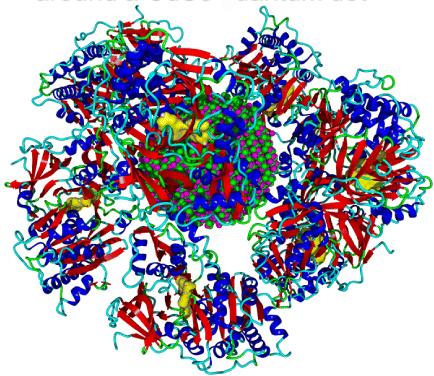Shining a light on quantum dots measurement

This is the protein corona of firefly luciferase around a CdSe quantum dot. Credit: Shikha Nangia and Arindam Chakraborty
When quantum dots are introduced in biological media, proteins surround the nanoparticles and form a corona. The formation of the protein corona changes the sensitivity of the quantum dots to light.
Using the cadmium selenide quantum dot, researchers at Syracuse University collaborated to understand how protein corona forms and what is different about the quantum dot before and after the formation of the corona.
Research performed by Professor Shikha Nangia, in the Department of Biomedical and Chemical Engineering, and Professor Ari Chakraborty, in the Department of Chemistry, resulted in the development of a novel multilevel computational approach.
This method combines the strengths of quantum mechanics, molecular mechanics, classical molecular dynamics, and Monte Carlo techniques. Because of this work, it is now possible to perform computer simulation of protein-quantum dot complexes that were previously considered to be beyond the scope of computational investigations. Now that this methodology has been created, it can be applied to bigger and more complex quantum dot systems.
###
Their paper, “Optical Signature of Formation of Protein Corona in the Firefly Luciferase-CdSe Quantum Dot Complex” is featured on the cover of the January issue of the Journal of Chemical Theory and Computation.
Media Contact
All latest news from the category: Life Sciences and Chemistry
Articles and reports from the Life Sciences and chemistry area deal with applied and basic research into modern biology, chemistry and human medicine.
Valuable information can be found on a range of life sciences fields including bacteriology, biochemistry, bionics, bioinformatics, biophysics, biotechnology, genetics, geobotany, human biology, marine biology, microbiology, molecular biology, cellular biology, zoology, bioinorganic chemistry, microchemistry and environmental chemistry.
Newest articles

NASA: Mystery of life’s handedness deepens
The mystery of why life uses molecules with specific orientations has deepened with a NASA-funded discovery that RNA — a key molecule thought to have potentially held the instructions for…

What are the effects of historic lithium mining on water quality?
Study reveals low levels of common contaminants but high levels of other elements in waters associated with an abandoned lithium mine. Lithium ore and mining waste from a historic lithium…

Quantum-inspired design boosts efficiency of heat-to-electricity conversion
Rice engineers take unconventional route to improving thermophotovoltaic systems. Researchers at Rice University have found a new way to improve a key element of thermophotovoltaic (TPV) systems, which convert heat…



